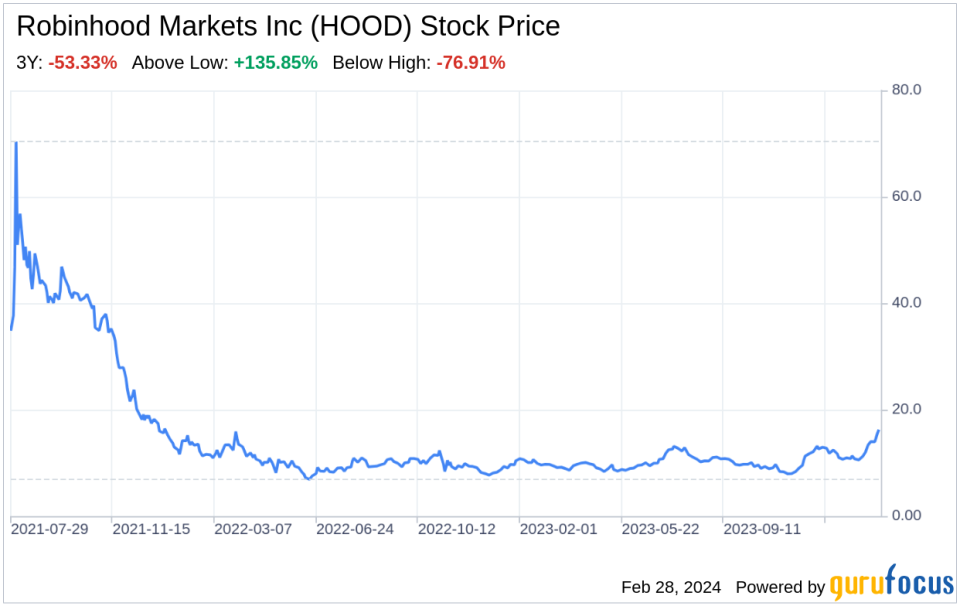Decoding Robinhood Markets Inc (HOOD): A Strategic SWOT Insight
Robinhood Markets Inc's innovative platform continues to democratize finance, attracting a new generation of investors.
Despite its rapid growth and strong brand, the company faces regulatory challenges and competitive pressures.
Opportunities for international expansion and product diversification present potential growth avenues.
Threats include market volatility, cybersecurity risks, and potential changes in regulation affecting revenue streams.
On February 27, 2024, Robinhood Markets Inc (NASDAQ:HOOD) released its 10-K filing, offering a comprehensive look into its financial health and strategic positioning. As a modern financial services platform, Robinhood has disrupted the industry with its app-based, user-friendly services, including commission-free trading and cryptocurrency transactions. The company's financial overview reveals a commitment to growth and innovation, with a focus on expanding its customer base and product offerings. However, the filing also acknowledges challenges such as regulatory scrutiny and the need for continuous technological advancement. This SWOT analysis will delve into the strengths, weaknesses, opportunities, and threats as presented in the latest SEC filing, providing investors with a nuanced understanding of Robinhood's market position.

Strengths
Brand Recognition and User Experience: Robinhood Markets Inc (NASDAQ:HOOD) has established a strong brand identity synonymous with modern, accessible investing. Its user-centric design and intuitive app interface have attracted a substantial user base, particularly among younger investors. The company's commitment to a "safety first" philosophy and radical customer focus has fostered trust and loyalty, which are critical in the financial services sector.
Innovative Product Suite: The company's vertically integrated platform allows for rapid deployment of new features and services, such as cryptocurrency trading and IPO Access. This agility in product development keeps Robinhood at the forefront of industry trends and customer demands, reinforcing its market position.
Technological Infrastructure: HOOD's investment in proprietary technology, including a self-clearing system and machine learning capabilities, provides a competitive edge. These technologies enhance the customer experience, improve operational efficiency, and contribute to the company's ability to scale effectively.
Weaknesses
Regulatory Compliance and Litigation Risks: Robinhood's reliance on transaction-based revenue, particularly payment for order flow (PFOF), exposes it to regulatory risks. The potential for new regulations or bans on PFOF poses a significant threat to its revenue model. Additionally, ongoing litigation and regulatory investigations could impact the company's reputation and financial stability.
Operational Scaling Challenges: As Robinhood continues to grow, managing its business effectively becomes increasingly complex. The company acknowledges difficulties in scaling its workforce and maintaining consistent growth, which could hinder its ability to meet customer expectations and regulatory requirements.
Market Dependence and Competition: The company's financial performance is subject to market fluctuations, which can lead to volatile quarterly results. Moreover, intense competition from both established financial institutions and emerging fintech players could erode Robinhood's market share.
Opportunities
International Expansion: Robinhood has identified significant growth potential outside the United States. With plans to expand into new markets like the United Kingdom and the European Union, the company can tap into a larger customer base and diversify its revenue streams.
Product Diversification: The company's roadmap includes the development of an ecosystem of financial products and services, which could attract and retain customers with varying financial needs. This strategy could lead to increased wallet share and customer lifetime value.
Technological Advancements: By leveraging its technological infrastructure, Robinhood has the opportunity to innovate further in areas such as AI and machine learning. These advancements can improve customer experience, enhance security, and streamline operations.
Threats
Regulatory Environment: The financial services industry is highly regulated, and changes in laws or regulations could necessitate significant adjustments to Robinhood's business model. Such changes could disrupt operations and require substantial resources to implement.
Cybersecurity and Data Privacy: As an online platform, Robinhood faces the constant threat of cybersecurity incidents and data breaches. Any failure to protect customer data could result in loss of trust, legal penalties, and financial loss.
Economic and Market Volatility: Robinhood's business is sensitive to economic conditions and market volatility. Adverse developments in global financial markets or a systemic market event could negatively impact trading volumes and, consequently, the company's revenue.
In conclusion, Robinhood Markets Inc (NASDAQ:HOOD) presents a compelling case of a company that has leveraged technology and innovation to disrupt the traditional financial services industry. Its strengths lie in its strong brand, customer-centric approach, and technological prowess. However, it must navigate the complexities of regulatory compliance, operational scaling, and intense competition. The opportunities for international expansion and product diversification are promising, but threats from the regulatory landscape, cybersecurity risks, and market volatility loom large. Investors should weigh these factors carefully when considering Robinhood's future prospects.
This article, generated by GuruFocus, is designed to provide general insights and is not tailored financial advice. Our commentary is rooted in historical data and analyst projections, utilizing an impartial methodology, and is not intended to serve as specific investment guidance. It does not formulate a recommendation to purchase or divest any stock and does not consider individual investment objectives or financial circumstances. Our objective is to deliver long-term, fundamental data-driven analysis. Be aware that our analysis might not incorporate the most recent, price-sensitive company announcements or qualitative information. GuruFocus holds no position in the stocks mentioned herein.
This article first appeared on GuruFocus.
